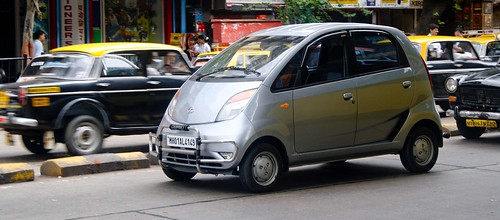The Tata Nano is an inexpensive, rear-engined, four-passenger city car built by the Indian company Tata Motors and is aimed primarily at the Indian domestic market, says Wikipedia.
Tata Motors began selling its "one-lakh car" in March, 2009.[5] The cheapest car in the world today,[6] though the price continues to rise[7] due to increasing material costs,[8] it is an exemplary example of Gandhian engineering, a concept involving deep frugality and a willingness to challenge conventional wisdom.[9]
The nickname, "one-lakh car" is due to the Nano's low price point, near Indian Rupee ₹100,000 (one lakh rupees).
The Nano's design implements many cost-reducing innovations.
* The Nano's trunk is only accessible from inside the car, as the rear hatch does not open.[23][24][25]
* One windscreen wiper instead of the usual pair[15][26]
* No power steering, unnecessary due to its light weight[15]
* Three lug nuts on the wheels instead of the usual four[26]
* Only one wing mirror[15]
* No radio or CD player[15]
* No airbags[15]
* 623cc engine has only 2 cylinders.
Announcing the vehicle as the least expensive production car in the world,[27] Tata aimed for a starting price of one lakh, or 100,000, rupees. This was approximately US$2000 at the time.[28][29] As of December, 2010, the cheapest Nano costs around US$2900.[7]
Rapidly rising material prices[8] (up 13% to 23% over the car’s development time[30]) caused it to cost somewhat more than Indian Rupee ₹1 lakh (US$2,220).
skip to main |
skip to sidebar
For students and parents who love education and exploration of the social sciences . . .
Search This Blog
Followers
Blog Archive
-
▼
2011
(242)
-
▼
March
(22)
- Intro to Vietnam
- Class of 2014 Talent Show performance night schedu...
- Indie work: Writer's Workshop resumes after the break
- Interview with a veteran of the Vietnam Conflict d...
- Caddo Magnet High Semester / Final Exam Schedule, ...
- India, Hinduism, Taj Mahal & Gandhi Review
- Mon: Feast of India / or comparison essay
- The Prepared, Artful Map
- Sikh people: the Golden Temple, or Harmandir Sahib...
- Lessons and notes from the movie Gandhi
- The Sacred Cow of India
- Feast of India - bring a dish or research a compar...
- Musical melodramas from Mumbai: the Bollywood movies
- Gandhiji! The goals of the great soul, or the Mahatma
- Intro to Gandhi
- Royal Bengal Tiger: down to a population of some 2...
- Tata Nano, a product of India and "the world's che...
- Write an essay on the Coates Bluff Trail for the L...
- Intro to India, the ancient and mystical land east...
- Coates Bluff Trail and Carnival quiz next class
- The Roots of Carnival quiz
- Brief essay on Carnival / Mardi Gras: observing th...
-
▼
March
(22)

